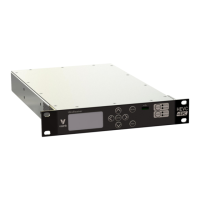UltraReceiver User Manual
Receiver Setup
Issue No: 3 Page: 29
Ref: ULRX-ASUM-700X Copyright © 2018 Vislink plc
The main functions that require configuration at the receiver are:
Demodulation scheme in operation; LMS-T/DVB-T or ASI input – See Section 6.1.
Type of down converter and operating frequency – See Section 6.2.
Decoder – See Section 6.3.
The demodulator in the receiver can operate in three main types:
1. Single Pedestal LMS-T(S) (if licensed)
2. Dual Pedestal LMS-T(D) (if licensed)
3. DVB-T (if licensed)
Demodulation options are selected in the DEMOULATOR > INPUT Menu. You can select
either LMS-T or DVB-T.
Select the demodulator type and bandwidth from the DEMOULATOR > INPUT > Demod
type menu.
Select the Bandwidth from DEMOULATOR > INPUT > Bandwidth menu.
NOTE: When using dual pedestal bandwidths in LMS-T mode, the bandwidth shown is the
combined width of the two pedestals.
The LMS-T bandwidths:
Single Pedestal:
3, 4, 5, 6, 7, 8, 10, 12 MHz
Dual Pedestal:
4, 6, 8, 10, 12, 14, 16, 20 & 24 MHz
The DVB-T bandwidths:
6, 7 & 8 MHz
NOTE: After any change, a screen stating “Please Wait” displays while the unit saves the
new settings.

